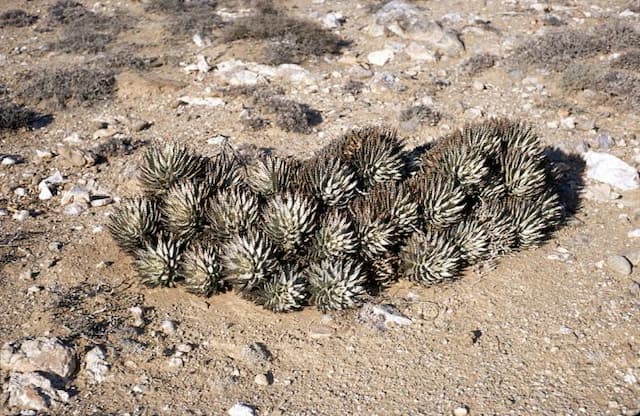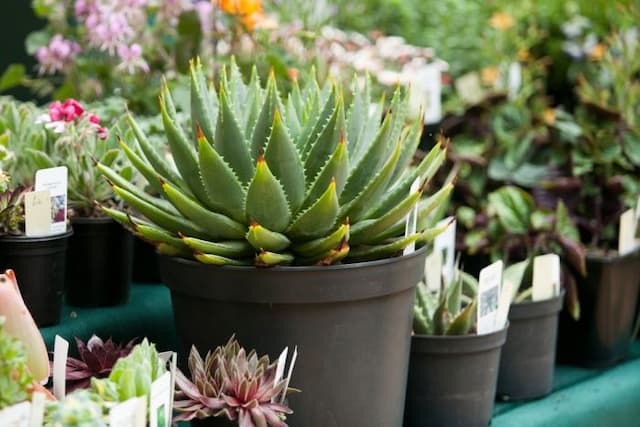Red Hot Poker Kniphofia triangularis subsp. triangularis 'Light of the World'

ABOUT
The 'Light of the World' is a stunning variety that adds a distinctive flair to any garden. Its appearance is characterized by a vibrant display of flower spikes, which bear a striking resemblance to brightly colored torches. These flower spikes feature a gradient of warm colors, starting with a bright, sunny yellow at the bottom and transitioning to fiery orange and then to a radiant red at the tip that seems to capture the essence of a tropical sunset. The leaves of this plant are also worth noting; they form a lush, grass-like clump with a rich green color that serves as the perfect backdrop for the dramatic flowering stems. The leaves are long and slender, resembling blades of grass, and they arch gracefully, softening the plant's silhouette. This plant's blooms not only provide a burst of color but also attract hummingbirds and other pollinators, adding life and movement to the garden. The overall appearance of 'Light of the World' is one of energy and brightness, making it a popular choice for gardeners looking to inject some visual warmth into their landscapes.
About this plant
 Names
NamesFamily
Asphodelaceae
Synonyms
Red Hot Poker, Torch Lily, Poker Plant, Tritoma
Common names
Kniphofia triangularis subsp. triangularis 'Light of the World'.
 Toxicity
ToxicityTo humans
Kniphofia, commonly referred to as Red Hot Poker, typically does not have high toxicity to humans. However, all parts of the plant can cause mild stomach upset if ingested due to saponins and other irritant substances. Handling the plant may also cause skin irritation in some individuals, though this is not common.
To pets
Kniphofia, or Red Hot Poker, is not listed as a toxic plant to pets, such as dogs and cats, by major animal care organizations such as the ASPCA. Nevertheless, it is possible for pets to experience mild gastrointestinal upset if they ingest parts of the plant, as it can be mildly irritating. It is generally advised to prevent pets from nibbling on garden plants to avoid potential issues.
 Characteristics
CharacteristicsLife cycle
Perennials
Foliage type
Evergreen
Color of leaves
Green
Flower color
Mixed
Height
2-3 feet (0.6-0.9 meters)
Spread
1-2 feet (0.3-0.6 meters)
Plant type
Herb
Hardiness zones
5
Native area
South Africa
Benefits
 General Benefits
General Benefits- Attracts Pollinators: Kniphofia, commonly known as Red Hot Poker, can attract bees, butterflies, and hummingbirds, benefiting your garden's pollination process.
- Low Maintenance: Red Hot Poker is well-known for being a hardy plant that requires minimal care once established, making it suitable for gardeners of all skill levels.
- Drought Tolerant: Once established, it can handle periods of dryness, perfect for arid climates or water-wise gardens.
- Seasonal Interest: With its striking flower spikes, Red Hot Poker provides visual interest from late spring to summer, enhancing garden aesthetics.
- Versatile Garden Use: It can be planted in flower beds, borders, and as a focal point, offering versatility in garden design.
- Tolerant of Various Soil Types: Red Hot Poker can thrive in a range of soil conditions, although it prefers well-draining soils.
- Long Blooming Period: The long-lasting blooms ensure a colorful display in the garden for an extended period.
- Erosion Control: The root system of Red Hot Poker can help to stabilize soil and prevent erosion on slopes or banks.
- Deer Resistant: It is generally resistant to deer, which makes it a good choice for gardens in areas where deer browsing is a problem.
- Cut Flower: Red Hot Poker makes an excellent cut flower for arrangements, with its tall, bold flower spikes adding height and interest.
 Medical Properties
Medical PropertiesThis plant is not used for medical purposes.
 Air-purifying Qualities
Air-purifying QualitiesThis plant is not specifically known for air purifying qualities.
 Other Uses
Other Uses- Red hot poker can be used in floral arrangements as its vibrant, torch-like flowers can add striking vertical interest and a splash of color.
- The nectar-rich blooms make an excellent food source for hummingbirds and butterflies in a wildlife garden.
- Red hot poker serves as a focal point in garden design due to its unique flower spikes, adding an architectural element to the landscape.
- The rigid structure of red hot poker can be used in crafting, particularly in making dried flower arrangements, as they retain their shape and color well.
- As a natural dye source, the flowers of red hot poker may yield various shades of yellow and green, ideal for textile dyeing.
- Red hot poker can be planted as a natural fence or border plant due to its height and density, providing a physical low barrier in gardens.
- The plant can be used in educational gardens to teach about plant pollination and the role of hummingbirds and insects in ecosystems.
- Due to their sturdy stems, red hot poker can be used as natural supports for weaker-stemmed plants in a mixed planting scheme.
- When used in xeriscape gardens, red hot poker contributes to water conservation efforts as it is drought-tolerant once established.
- Red hot poker can act as a companion plant in vegetable gardens, attracting pollinators that can increase the yields of fruit-bearing crops.
Interesting Facts
 Feng Shui
Feng ShuiThe plant Red Hot Poker is not used in Feng Shui practice.
 Zodiac Sign Compitability
Zodiac Sign CompitabilityThe plant Red Hot Poker is not used in astrology practice.
 Plant Symbolism
Plant Symbolism- Attention-Grabbing: The bright, torch-like flowers of the Red Hot Poker demand attention, symbolizing a call to focus or a beacon alerting others to take notice.
- Boldness: Its fiery blooms and striking appearance convey a sense of boldness and courage.
- Stand Out: The Red Hot Poker stands out in a garden, symbolizing individuality and the idea of being distinctive or unique.
- Energy: The vibrant, fiery colors are reminiscent of flames, suggesting high energy or an intense passion.
- Illumination: The common name 'Light of the World' conveys a sense of brightness, hope, and inspiration, like a guiding light or beacon in the darkness.
- Hardiness: The plant's ability to thrive in dry conditions symbolizes resilience and the capability to endure challenging circumstances.
 Water
WaterThe Red Hot Poker plant needs deep and thorough watering about once per week during active growth and far less during winter dormancy, approximately one gallon per plant depending on the soil moisture level. Water the plant at the base to avoid wetting the foliage, which can lead to fungal diseases. During the peak of summer, you may need to increase watering frequency to every 3-5 days but always check soil moisture first. It's essential to let the soil dry between waterings to encourage deep root growth and to prevent rot. Adjust watering based on rainfall, less water is necessary during wet seasons.
 Light
LightRed Hot Poker plants thrive in full sun conditions; they require at least six hours of direct sunlight daily. Place them in a spot where they will receive unobstructed sunlight to promote strong growth and vibrant flowering. A south-facing garden spot that receives abundant light is ideal for these plants.
 Temperature
TemperatureRed Hot Poker plants are adaptable to a range of temperatures, generally withstanding temperatures down to 14°F and thriving in temperatures up to 86°F. They perform best when the average temperature hovers between 60°F and 75°F. These plants are marginally frost-tolerant but can suffer from extended freezing conditions and extremely high heat.
 Pruning
PruningPrune Red Hot Poker plants in early spring to remove old foliage and encourage fresh growth. Deadhead spent flower stalks throughout the blooming season to promote additional blooms. Perform a more thorough pruning late in the fall, cutting back foliage to just above ground level after the first frost has occurred.
 Cleaning
CleaningAs needed
 Soil
SoilThe Red Hot Poker (most common name) thrives in well-draining soil rich in organic matter with a pH between 6.0 and 7.0. A mix of loamy soil with compost and coarse sand or perlite works well for ensuring proper drainage and fertility.
 Repotting
RepottingRed Hot Pokers do not need frequent repotting and can be typically repotted every 2 to 3 years to refresh the soil or when the plant has outgrown its current container.
 Humidity & Misting
Humidity & MistingRed Hot Pokers are fairly tolerant of a range of humidity levels but perform best in average atmospheric humidity, without the need for any special humidity requirements.
 Suitable locations
Suitable locationsIndoor
Place in bright, indirect light and keep soil moderately moist.
Outdoor
Plant in full sun, well-drained soil, and space 18 inches apart.
Hardiness zone
5-9 USDA
 Life cycle
Life cycle'Light of the World' is a perennial plant that begins its life as a seed, which after sowing germinates in moist, well-draining soil in a warm environment. Upon germination, the seedling emerges and establishes itself with a basal rosette of narrow, strap-like leaves, which will persist for several years. The plant enters a vegetative stage in which it focuses on leaf and root growth, preparing for future flowering. Once mature, typically within 2-3 years, it produces tall, upright flower spikes with tubular flowers that range in color from yellow to orange, blooming mainly in the summer months. After the flowering period, seeds are set, which can then be dispersed to create new plants. Finally, the plant may enter a period of dormancy during colder months, conserving energy to regrow in the following season.
 Propogation
PropogationPropogation time
Early Spring
For Red Hot Poker 'Light of the World', the most popular method of propagation is by division. This is ideally done in the spring when the plant is emerging from dormancy and entering a period of active growth. To propagate by division, carefully dig around the plant to lift it from the ground, minimizing root damage. Use a sharp, clean knife or spade to divide the clump into smaller sections, ensuring that each division has a good portion of roots and several shoots. Replant the divisions immediately at the same depth they were growing before, spacing them about 18 inches (approximately 45 centimeters) apart to allow for growth. Water the new divisions thoroughly to help establish them in their new locations.









